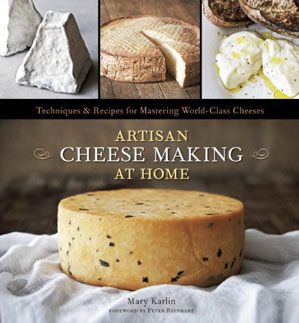MORE ABOUT MILK
It is in this section that noteworthy additional or new information about milk will be presented as it becomes available. Here’s an overview of what we cover in Artisan Cheese Making at Home. Milk is where all cheese making starts. As acknowledged in the book, it is the primary building block of cheese. Milk is produced by ruminant animals (hoofed animals with multi-chambered digestive systems) as nourishment for their young but it is also used as food for humans. Ruminant milk has a unique protein structure that enables coagulation which is essential for cheese making. The primary animal milks used for cheese making come from cows, goats, sheep and water buffalo. The type of milk used (cow, goat, and sheep) for cheese making does not determine the style of cheese being made since the variety of cheese making milks are used for all styles of cheese.
For cheese making purposes, these primary components of milk are what we are interested in:
- Whey (the liquid) = Mostly Water + Proteins + Lactose + Ash (minerals)
- Sugar = Lactose, the milk sugar which needs to be metabolized to produce lactic acid
- Protein = Caseins, the primary proteins for cheese making
- Fat = Butterfat, the taste globules. A higher fat content results in better flavor in the final cheese
Choose Your Milk Wisely. Buyer Be Aware
The milks used for cheese making can be: Raw, Pasteurized, Homogenized, or Pasteurized and Homogenized. Ultra-Pasteurized (UP) or Ultra-high Temperature (UHT) milks will not form proper curds for cheese making.Familiarize yourself with the meanings of the milk processing terms and ingredients on milk carton labels. Make it your mission to understand what these terms mean and their effect on the milk and ultimately you. Also become aware of milks that have stabilizers or thickeners added. Try to avoid these milks if possible. These additives can inhibit proper coagulation and curd development in cheese.
Raw milk
Raw milk has naturally occurring flora not present in processed milk. When used for cheese making, less starter culture, if any, will need to be added to the raw milk than to pasteurized milk to start the cheese making process.Though most home-crafted cheeses will most likely be made with store-bought pasteurized milk, you can still make fabulous, great tasting cheeses. The terroir nuances imparted from regional raw milk may not be present, but your cheese will still have a fantastic flavor due to the nuances you and your ingredients have imparted.
If raw milk is what you desire, but it is not available from a local retail source, one option is to buy into a local ‘herd share’ program as access to raw milk. Though still illegal for raw milk to be sold in many states, where legal, you can buy your share of milk from a specific farmer who cares for the animal for you. As a share-holder you get fresh local milk and you are supporting a small dairy farmer in the process. See Milk Resources (page 240) for more information.
Start With High Quality Milk
Whether raw or pasteurized, find a reputable locally-produced source for high quality milk. You must start with quality milk to make quality cheese. Smaller, local dairies
and processing plants are the ones to support. Ultimately, it is the quality of the milk that is more important than whether it is raw or pasteurized. Once you have a source
you like for making cheese, stick with that one. Read the labels for processing procedures and sell-by dates. Always buy the freshest milk available. Old milk does not make
good tasting cheese.
